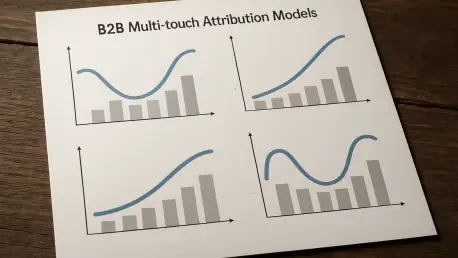B2B sales cycles are complex, involving multiple touchpoints and stakeholders, and often taking months to close a deal. To navigate this, companies use multi-touch attribution to clarify the buyer’s journey and pinpoint how marketing and sales contribute to success. However, implementing this can be challenging. Choosing the right model, integrating it with existing tools, and turning insights into measurable results are key concerns. This guide simplifies the concept of multi-touch attribution and outlines essential methods you can use in your B2B organization.
Why Multi-touch Attribution Matters for B2B Marketing
By understanding how prospects move from awareness to consideration to purchase, teams can identify the most effective campaigns and content. This clarity enables marketers to allocate resources strategically and ultimately drive higher revenue while shortening sales cycles. Read on for a full breakdown of its benefits.
Benefits of B2B Multi-Touch Attribution
If you are not utilizing marketing attribution, you are missing out on valuable insights and potential revenue. Here are the primary benefits of this marketing strategy.
Optimize ROI and Resource Allocation
B2B marketing attribution helps identify which activities are most effective in driving results. This enables businesses to utilize their resources more effectively. For example, if webinars consistently generate high-quality leads, you can increase the budget allocated to them. It also identifies which channels are not performing well, enabling you to eliminate waste and allocate resources to more effective activities.
Gain End-to-End Customer Journey Insights
This approach also identifies key moments, such as when technical evaluators view product documentation or stakeholders check pricing guides. Successful deals often exhibit patterns, such as prospects reading solution briefs before demos, which can lead to quicker closures. Additionally, attribution data highlights engagement trends across roles; for example, a CTO may attend technical webinars, while a CFO often uses ROI calculators.
Improve Sales and Marketing Alignment
Sales and marketing often work independently, but B2B attribution can create a unified view of success. Attribution data helps both teams identify effective touchpoints for generating and converting leads. For example, the sales team can analyze successful campaigns for key accounts, while marketing can pinpoint leads with a high closing potential. Additionally, attribution supports closed-loop reporting, enabling both teams to track the entire customer journey and identify areas for improvement.
Data-Driven Decision-Making
By utilizing B2B marketing attribution, companies can make informed decisions based on solid data rather than speculation. For example, insights may reveal that technical white papers yield twice the conversions of blog posts, or that targeted email sequences increase deal velocity by 30%. With this analytics-driven strategy, teams can experiment with various tactics and precisely evaluate their impact on pipeline metrics.
Enhanced Marketing Accountability
Attribution introduces an enhanced level of responsibility within your team, allowing marketers to demonstrate how their activities directly impact profitability. This clarity not only fosters trust among stakeholders but also helps justify marketing expenditures and secure future funding. Attribution showing that a recent product launch campaign drove significant new customer acquisitions makes it easier to request more resources for similar projects.
Improved Forecasting and Predictive Modeling
B2B marketing attribution not only clarifies past performance but also lays the groundwork for predicting future results. You can examine past conversion trends to identify which early engagement indicators imply a strong intent to purchase. For instance, prospects who download technical specifications and participate in product demonstrations within a two-week timeframe are 75% more likely to convert. This forecasting model enables teams to concentrate their efforts on the opportunities with the highest potential for closing, while also taking measures to address deals that may be at risk.
B2B Multi-Touch Attribution Models
Not every multi-touch attribution model is created equal, and choosing the right one can significantly impact how effectively you measure and optimize your marketing efforts. Each one distributes credit for conversions differently across touchpoints, reflecting unique assumptions about buyer behavior and the sales cycle. Understanding the strengths and limitations of each solution is essential for selecting the one that aligns with your B2B strategy, accurately captures your buyer journey, and delivers actionable insights to drive growth.
Linear Attribution Model
The linear attribution approach assigns equal importance to all touchpoints throughout the journey. Regardless of whether it’s the first ad click or the last sales call, each interaction earns the same proportion of credit for the conversion. If a deal valued at $100,000 includes five touchpoints, each one is credited with $20,000.
Pros:
Easy to implement and clarify to stakeholders.
Neutral regarding particular touchpoints or channels.
Eases attribution analysis for teams with limited resources or novice-level analytics proficiency.
Offers a consistent attribution framework for experimentation.
Equitable allocation of credit among all touchpoints.
Cons:
Places too much emphasis on less critical interactions.
Lacks accuracy in improving effective channels.
May downplay the importance of the final conversion points.
Simplifies complex B2B buying processes too much.
Ignores differences in timing and effects among touchpoints.
Not suitable for advanced marketing strategies.
Time Decay Attribution Model
The time decay model assigns greater importance to touchpoints that are closer to the conversion event, meaning that the credit increases significantly as potential customers move closer to a purchase. For instance, the last touchpoint may earn 40% of the credit, whereas the initial touchpoint only receives 5%.
Pros:
Customer choices are often shaped by their recent interactions. It’s essential to consider both initial contact points and those that ultimately lead to final decisions.
This approach helps identify which late-stage campaigns encourage leads to take action.
It works well for companies with long sales cycles, where the later stages are more important.
This method effectively captures how buyer intent evolves, particularly in industries such as SaaS or high-value sales.
Cons:
It underestimates how important it is to promote awareness early on.
May overlook the long-term effects of activities at the start of the sales process.
Assumes that recent interactions are always the most important, which may not be true for all industries or campaigns.
It can be misleading for short sales cycles where early interactions heavily influence decisions.
It is less effective for products or services that require building brand trust over time.
Requires accurate tracking of all interactions, which can be challenging for businesses with offline or complex customer journeys.
U-shape Multi-Touch Attribution Model
The U-shaped approach assigns the highest credit to the first and last touchpoints, with each receiving 40%. The remaining 20% is allocated to the intermediate interactions. Here are some of the results this method yields:
Pros:
Emphasizes the significance of both initial and final touchpoints.
Provides a more refined perspective than single-touch solutions, yet is simpler than several complex multi-touch models.
Effectively integrates with the majority of B2B buying processes.
Ideal for examining customer journeys in sectors where there are distinct handoff moments between marketing and sales teams.
Cons:
This approach can be confusing because activities in the middle stage are essential. It does not give a complete view of the entire funnel.
It may not work well for complex or non-linear customer journeys where the touchpoints do not follow a simple order.
W-Shaped Multi-Touch Attribution Model
The W-shaped model assigns 30% of credit to the first touch, lead generation, and conversion, with the remaining 10% allocated to other interactions.
Pros:
This approach provides a broader perspective than U-shaped models by incorporating input from all stages, including the middle, early, and late stages.
Helps companies improve their marketing strategies in three key areas.
Balances simplicity and complexity effectively.
It is a great way to evaluate all parts of multi-channel campaigns by using a simple and easy-to-understand solution.
Encourages investment in both early-stage and final-stage activities.
Cons:
Using this approach can simplify complex sales processes that involve many stakeholders.
The model may overlook the importance of building relationships between generating leads and converting them into more complicated customer journeys.
It is also more challenging to explain than simpler methods, such as linear or U-shaped attribution.
Lastly, it doesn’t fully account for irregular or non-linear customer paths.
Custom Multi-Touch Attribution Model
A tailored multi-touch attribution model is customized to meet your unique business requirements. Plus, you determine how credit is allocated. Here is an extensive list of pros and cons:
Pros:
Ensures a balance of credit between brand awareness and performance initiatives, preventing any stage of the funnel from being overlooked.
Delivers the most precise insights and facilitates advanced optimization techniques.
Makes the most out of marketing spending by identifying where to put more resources based on the biggest interactions.
Cons:
Smaller teams lack the necessary resources for frequent adjustments and may experience limited scalability.
There is a risk of too much customization without clear standards to follow.
If there are gaps in the data, the attribution model might not work properly. Incomplete tracking can result in misleading conclusions.
There is a risk of bias if teams assign weights based on assumptions rather than using reliable data or conducting thorough testing.
Conclusion
B2B multi-touch attribution is no longer a luxury; it’s a necessity for organizations looking to optimize marketing performance. Start tracking interactions across the entire buyer journey, and gain actionable insights into which touchpoints truly influence conversions and revenue. While selecting the right attribution model depends on your sales cycle and available data, the ultimate goal remains the same: to maximize ROI. When implemented thoughtfully, multi-touch attribution transforms fragmented data into a clear roadmap for driving growth and sustaining a competitive advantage in complex B2B environments.









